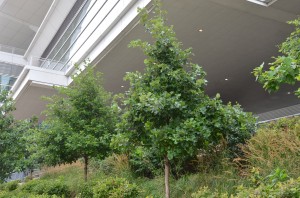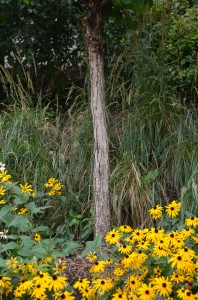Swamp white oak (Quercus bicolor) is an underutilized large native oak whose ornamental attributes have captured the attention of municipal arborists (and perhaps you as well). (USDA hardiness zones 4 to 8). Swamp white oak is a medium to large sized deciduous shade tree, 50 to 60 feet tall and wide, and a broad, irregularly shaped canopy. Compared to some oak species, its growth rate is moderate, 12-15 inches annually. Larger specimens over 70 feet tall exist but are not common.
As its common name indicates, this native oak is indigenous to moist to swampy locations in bottomlands and lowlands, along streams and lakes, on floodplains, and on the edge of swamps. It is not fussy growing in average soil, dry, medium or wet, and moderately acidic (4.5 – 6.5), and in full sun. Established trees turn out to exhibit good drought resistance and are long-lived. Tree is widely adaptable to adverse soil conditions such as periodic flooding or prolonged drought. Yellowing of the foliage in the summer (chlorosis) may occur when the soil is not acidic enough. Additions of chelated iron to the soil will correct the problem over a few years.
Leaves are 3 to 7 inch long with 3-7 pairs of rounded lobes and very short petioles. Its deep green summer foliage color holds late into fall, turning russet-brown in early winter before abscising. Young trees tend to hold their leaves into the early winter. In mid-spring strings of male and female catkins flowers emerge and hang from branch tips shortly before leaves emerge.
Acorn fruits are sweet and can be eaten right off the tree; they’re an important food source for many forms of wildlife. Young trees show off a pale gray bark that exfoliates; older mature trees exhibit a sturdy furrowed bark of winter interest to some who love the outdoors.
Swamp white oak is a member of the white oak group along with white oak (Q. alba), bur oak (Q. macrocarpa), Chinkapin oak (Q. muhlenbergii), English oak (Q. robur), and post oak (Q. stellata). This group is identified by their rounded (not pointed) leaf lobes and acorns that mature in one growing season.
Swamp white oak is susceptible to numerous diseases and pest problems, including anthracnose, cankers, leaf spots, rusts, galls, caterpillars, borers, leaf miners, lace bugs, and mites. Most occur in late summer and are of little consequence.
A balled and burlap (b&b) tree should best planted from late winter through spring. Swamp white oak has no cultivars to select from, but hybrid forms do exist. In recent years many urban communities have been planting swamp white oak in parks, golf courses, and in large commercial and residential properties.



 Posted in
Posted in 
